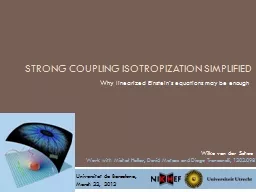

Why linearized Einsteins equations may be enough Wilke van der Schee Universitat de Barcelona March 22 2012 Work with Michał Heller David Mateos and Diego Trancanelli 12020981 Outline ID: 791564
Download The PPT/PDF document "Strong coupling isotropization simplifie..." is the property of its rightful owner. Permission is granted to download and print the materials on this web site for personal, non-commercial use only, and to display it on your personal computer provided you do not modify the materials and that you retain all copyright notices contained in the materials. By downloading content from our website, you accept the terms of this agreement.
Slide1
Strong coupling isotropization simplified
Why linearized Einstein’s equations may be enough
Wilke van der Schee
Universitat de Barcelona,
March 22, 2012
Work with Michał Heller, David Mateos and Diego Trancanelli, 1202.0981
Slide2Outline
Motivation: heavy ion collisionsQCD dual very far away, but encouraging resultsSimple set-up for anisotropy
Full & linearized calculationPictures/conclusions/outlook
2
Slide3Elliptic flow: v2
3
How anisotropic is the final state?Ideal gas/weak couplingPerfect fluid/strong coupling
K.
Aamodt
et al, Elliptic
Flow of Charged Particles in
Pb-Pb
Collisions at √
s
NN
=2.76
TeV
(2010)
Slide4Large N gauge theories
At strong coupling we can get GR
G. ’t
Hooft
, A planar diagram theory for strong interactions (1974)Planar limit:
fixed
4
Slide5Simplest set-up:
Pure gravity in AdS
5
Background field theory is
flat
Translational- and SO(2)-invariant field theoryWe keep anisotropy:Caveat: energy density is constant so final
state is known
Holographic context
5
P.M.
Chesler
and L.G.
Yaffe
, Horizon formation and far-from-equilibrium
isotropization
in
supersymmetric
Yang-Mills plasma (
2008)
Slide6The geometry
6
Symmetry allows metric to be:
A, B, S are functions of r
and tB measures anisotropy Einstein’s equations simplifyNull coordinatesAttractive nature of horizon
Key differences with Chesler, Yaffe
(2008) areFlat boundaryInitial non-vacuum state
Slide7Full evolution
7
The Einstein equations are particularly simple
Take derivatives along null directions:
Nested set of linear ordinary differential equationsTake , obtain and respectively Try to keep event horizon on grid
H.
Bondi, Gravitational Waves in General Relativity (1960)
P.M
.
Chesler
and L.G.
Yaffe
, Horizon formation and far-from-equilibrium
isotropization
in
supersymmetric
Yang-Mills plasma (
2008)
Slide8Boundary conditions
8
AdS requires boundary conditions:Non-normalizable: metric field theoryNormalizable: stress-energy tensorImplies asymptotic behaviour metric:
AdS
/CFT
Slide9The close-limit approximation
9
Early work of BH mergers in flat spaceSuggests perturbations of an horizon are always small
Linearize evolution around final state (planar-
AdS-Schw):
Evolution determined by single LDE:
R. H. Price and J.
Pullin
, Colliding black holes: The Close limit (1994)
Slide10Quasi-normal mode expansion
10
Expansion:Solution possible for discreteImaginary part always positive
G.T. Horowitz and V.E.
Hubeny, Quasinormal Modes of AdS Black Holes and the Approach to Thermal Equilibrium(1999)J.
Friess, S. Gubser,
G. Michalogiorgakis, and S. Pufu, Expanding plasmas and
quasinormal
modes
of anti-de
Sitter black
holes (2006)
Slide1111
First results (Full
/Linearized/QNM)
Slide12Initial states
12
Wide range of initial statesRandom: ratio 10th order polynomials, minus subtractionNear boundary (UV), middle, near horizon (IR)
Wiggly ones, combinationsThermalized: dynamics ≈ hydrodynamicsHomogeneous no flow no anisotropy
Our criterion:
Slide13A subtlety: Bmax
13
Try to get state “maximally” far from equilibrium and implies curvature singularity!
Should be behind event horizon (physically/numerically)We tried:Start with some B
, with B not too bigMultiply B with 1.1, stop if numerics are unstable
In practice: (where zh=1)In this way we can get low initial entropies!
NB: no limit on (anisotropy), but needs to be in UV
Slide14Anisotropy
14
Linearized approximation works very well! (dashed)
Last one with QNM
Profiles located in IR (near horizon) thermalize later
M. Heller
,
R.
Janik
and
P.
Witaszczyk
,
The characteristics of
thermalization
of boost-invariant plasma from
holography (2011)
Slide15B(z, t) and the linearized error
15
Slide16B(z, t) and the linearized error
16
Extreme IR example:
Slide17Area horizons
17
“Entropy” rises quickly
Not always an apparent horizon; always inside event horizon
Slide18Statistics of 2000 profiles
18
Slide19Statistics of 2000 profiles
19
An accuracy measure (angle in L2-space):
Slide20Connection with heavy ions
20
Hard to say:Homogeneous system no flow
Pure gravity only provides toy modelBut encouraging results:
Linearized approximation works excellent for normalInitial profile is expected near the boundary (UV)Maybe it works well in more realistic cases? (in progress!)
Slide21Conclusion
21
Studied (fast!) isotropization for over 2000 statesUV anisotropy can be large, but
thermalizes fastLinearized approximation works unexpectedly wellWorks even better for UV profiles
Caveats:Homogeneous system, final state already knownNo hydrodynamic modesFuture directions: higher order, boost-invariant flow, shockwave collisions, non-local observables
Slide22Better correlation
22
The maximum of B and the maximum of D
PNL-D
PL